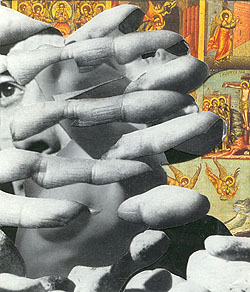CLOAK/3.6iClustered among the capital city's tumbled skirts of quaint and sordid dwellings, raising property values almost inadvertently, students and graduates of the state college of art keep to their secret shrines and potions, their violent devotions, their crowded scheming and mobbish vandalisms, their market stalls crammed with objects suggestive of flaying and dismemberment, their crowded books of saints and absurd saintly poses. |
|
Reality is poison, Cloak is the antidote. Appearance is poison, Cloak is the antidote. Reality is appearance, poison is the antidote. |
| Hideous view of a car-logged street and pigeon-spotted paving, the napalm scars of canine occupation, a gray-green scrim of frost-interrupted sprouting. Friday nights across the street around ten o'clock arrive all these abuelita types carrying plastic bags of what the art students assume to be chicken. Down the hill, a slow sluicing of guns and glass and lottery litter past the bus stop where drunks of color bum their cigarettes. |
| Cloak—up the river into collage. |
They're tired—without their Cloak the art students are mainly tired. Up in the attic, a sleepwalk among billowing cobwebs, bumps in the night breeding scares and wild self-diagnoses of the utmost fatalism. They're taking anti-candida tisanes but suspect it's too late, and that some great single-celled organism is already stuck all through them like an enormous nylon sock, plugging them into a sealed hive of sweet chronic underachievement. On the bus, on the train, the fungal moors inside their heads will sometimes shudder in tandem with the upthrust of this fear—like calls to like, their hypochondria is like a Stonehenge strung among the sullen aisles.
   
|
